At the Intel Memory and Storage Moment 2020, the company is finally unveiling its newest Optane SSD. Dubbed the Intel Optane P5800X, the new PCIe Gen4 NVMe SSD utilizes Intel’s next-gen technology to put up impressive if not downright game-changing performance figures.
New Intel Optane P5800X 100 DWPD SSD
The new Intel Optane P5800X SSD, as we already noted pushes the 100 DWPD barrier. Effectively, it is designed not just as a high-endurance SSD, but it is designed to be an easy-to-integrate write buffer for almost any high-speed write application. Let us get right to the specs of this new PCIe Gen4 NVMe SSD.

Intel is putting up some absolutely awesome write performance figures here in the 6.2GB/s range while maintaining 7.2GB/s read speeds. With its next-gen Optane media, it is able to hit 1.5M read or write random 4K IOPS. It can do even better in mixed workloads due to PCIe Gen4 being bi-directional so it can go faster than the speed limits of PCIe Gen4 in all read or all write directions when running in the 70/30 usage patterns. These drives are designed for 400GB, 800GB, 1.6TB, and 3.2TB capacities. When One has 3.2TB and a 100 DWPD rating, that means that these drives can be rated at over 2PB/ week of write endurance.
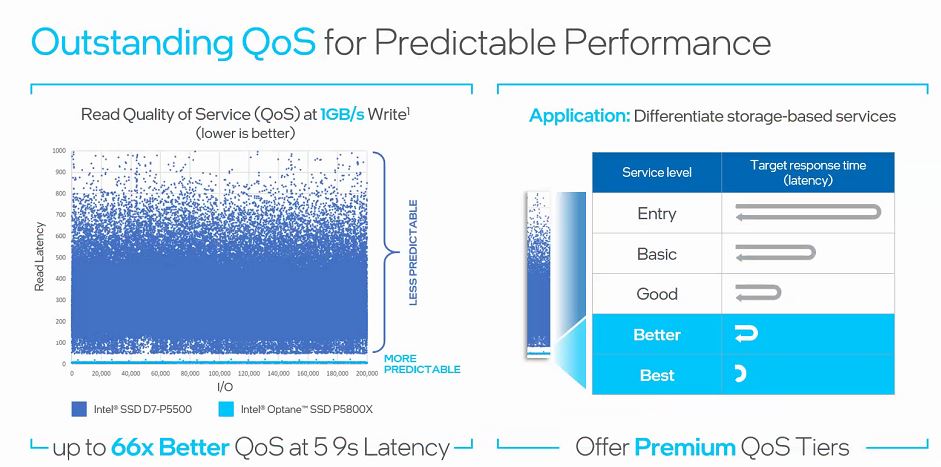
One of the big drivers here is that Intel’s cloud customers are looking at how they can have local caches for block storage and provide excellent QoS. The company’s direction is that one can use these high-endurance 400GB drives in smaller quantities to get the level of performance required for 100Gbps networks. As such, although one spends more per GB, using fewer drives and at lower capacities means one can more efficiently deploy resources. That is one of the more interesting marketing pitches for what is likely significantly pricier storage than the company’s TLC NAND offerings.
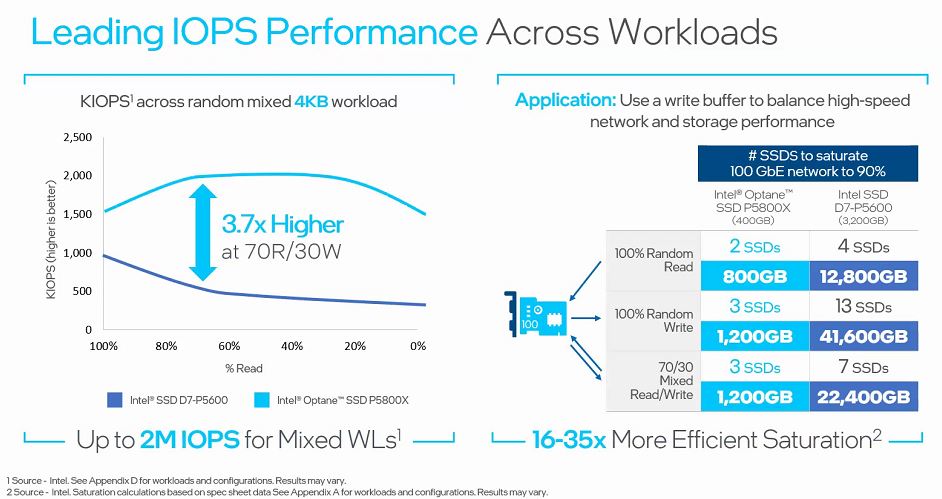
Just to highlight the latency versus load performance, one can see that the new Optane SSD goes well beyond the older Optane P4800X limited by first-gen technology, PCIe Gen3, and a relatively paltry 60 DWPD rating.
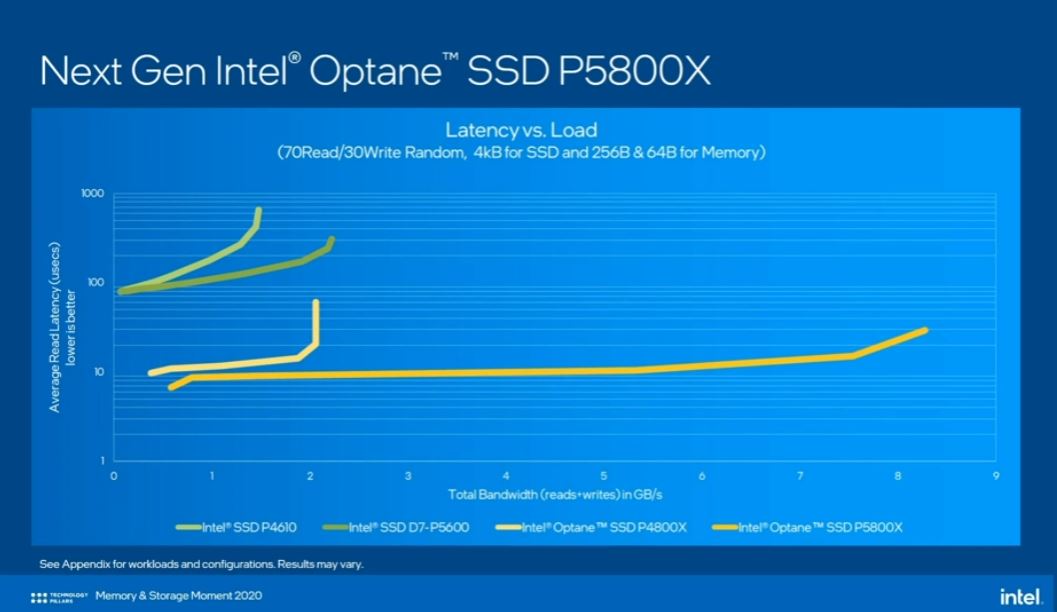
Aside from the consistent performance, we would expect, Intel is also showing off the performance per GB. Using the smaller SSD sizes, Intel is able to push the IOPS per GB of storage while maintaining low latency and excellent tail latencies.
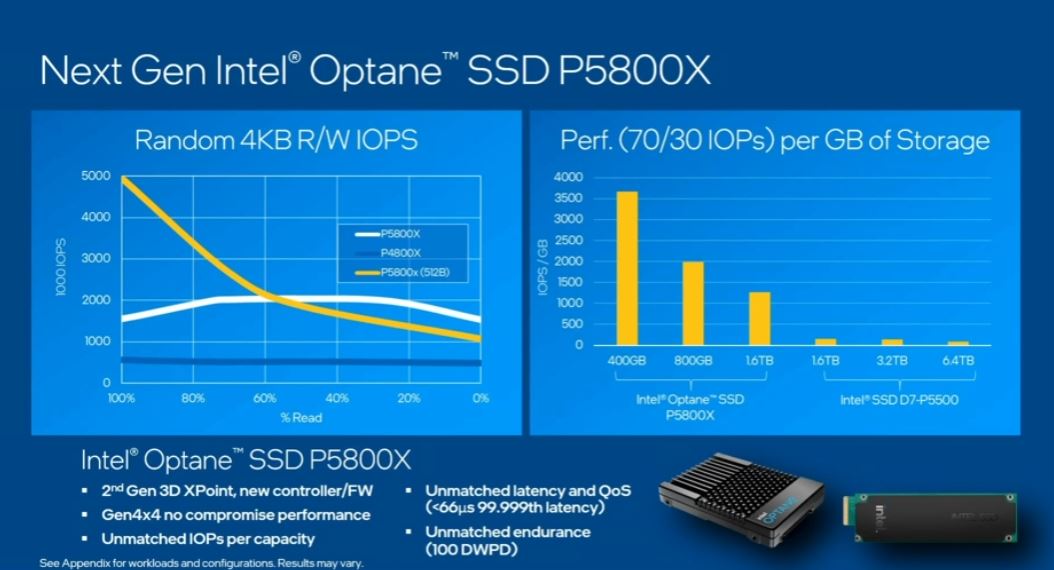
Technology is moving forward in a big way as Intel as a company gets behind PCIe Gen4 with Ice Lake Xeons later in 2021.
Final Words
Yes, these are fast SSDs, and probably will be the fastest storage with decent capacity on the market for some time. Something interesting that we noticed is that Intel is only announcing the U.2 drives on the spec page. Not only is it interesting that the company is using U.2 NVMe here, but it is showing something else not mentioned explicitly. In the last image above, shown as part of the keynote, Intel has what appears to be an E1.S Optane P5800X drive. Since many hyper-scalers have migrated to the newer form factor that we highlighted in pieces such as the Facebook Introduces Next-Gen Cooper Lake Intel Xeon Platforms and Hands-on with the 1U Half-Petabyte Supermicro EDSFF Server, it makes sense that we are seeing Intel with next-gen form factor options.
For the foreseeable future, the P5800X is going to be the SSD to beat for raw performance.

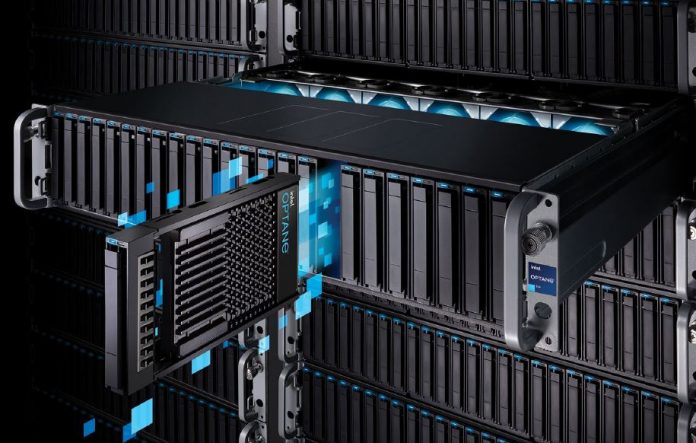



Do these work on for example an AMD X570 platform?
If you can obtain a PCI-E 4.0 compatible M.2-U.2 adapter cable, then yes.
@Patrick What are the chances Intel supply one of these for testing? Would love to see how this compare to SSD on Database workload.
@Koss or a OCuLink to u.2 then you can use the pcie 4.0 links on the Asrock Rack AMD Boards. I have asked Asrock what cable they recommend but haven’t heard back yet. Microsata cables have a oculink to oculink cable for pcie 4.0 plus am adapter for ocukink to m.2 pcie 4.0 both together is 130ish USD though.. and no word if I need their expensive rediriver card also which then needs a pcie 4.0 pcie slot and so defeats the entire purpose…
@ Patrick, Could this be used a secondary RAM storage for large CFD work to reduce total ram usage. It would appear that ddr4 maybe up to 3.2gb/s while these drives run at 6.2-7.2gb/s?
wondering if this is possible method, and possible outcome?
@Cr8 Where did you get your RAM speed speeds from?: https://en.wikipedia.org/wiki/DDR4_SDRAM https://en.wikipedia.org/wiki/Double_data_rate
DDR4-3200 is up to 25.6GB/s, even 1600 is 4 times faster than your values
Jesper
he is conflating the Optane SSDs with the Optane NVDIMMs… so seriously doubt that it’s an actual request – If he is in charge of arch/hardware then they won’t be in business for long.
FYI: at Patrick’s video here:
“The Glorious Complexity of Intel Optane DIMMs and Why Micron Quit”
… We posted some preliminary numbers comparing max bandwidth of DDR4 and PCIe 4.0.
From specs now published for PCIe Gen4 and Gen5, it appears that PCIe will be scaling faster than future DDR4 and DDR5 DRAM products.
Also, Patrick explains how Optane DIMMs require the entire DRAM apparatus to DOWN-CLOCK to DDR4-2666! The is potentially a huge penalty to impose on a busy server configured with much faster DDR4.
As such, using x16 PCIe slots for “storage mode” appear much less complex as compared to Optane DIMMs.
(Just my 2 cents.)